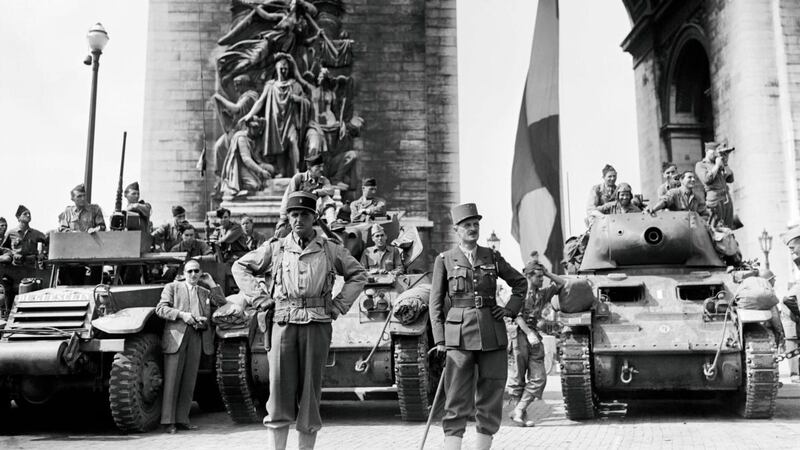Though other chapters of the second World War were more militarily significant, few can rival the symbolism and emotional impact of the liberation of Paris on August 25th, 1944.
The Hôtel de Ville will celebrate the 75th anniversary on Sunday with an homage to Marshal Leclerc’s 2nd armoured division (2e DB), a “freedom parade” and the inauguration of the new €20 million Musée de la Libération de Paris at the Place Denfert-Rochereau.
Henri Tanguy, a communist steel worker and veteran of the Spanish civil war whose nom de guerre was Col Rol, directed the battle for Paris from a bunker 26 metres beneath the landmark statue of a lion on the square at the southern end of Paris.
The bunker was built in 1938 as a logistics centre for city services including water, street lights and telephones in the event of bombardment, though it was never used for that purpose.
The Americans graciously took a back seat to the French, providing tanks, jeeps, machine guns, artillery and air support
Resistance members needed a password to enter the bunker. In about 50 telephone calls each day,Tanguy told the rag-tag Forces françaises de l’intérieur or FFI – known as “fi-fis” – where to attack German troops and armour.
After the Normandy landings in June, US general Dwight Eisenhower intended to bypass Paris on the Allied march to the Rhineland, because the battle was likely to be costly in men and equipment, and because he did not want responsibility for feeding 2 million Parisians.
But a popular insurrection had started on August 19th, when 2,000 policemen seized the prefecture and its armoury opposite Notre Dame from the Germans. The balance of power – and fear – gradually shifted, as Parisians used felled trees, paving stones and sandbags to erect some 600 barricades.
Gen Charles de Gaulle and Leclerc, whose full name was Philippe François Marie Leclerc de Hauteclocque, convinced “Ike” the Resistance could not hold out on its own for long.

Back seat
The Americans graciously took a back seat to the French, providing tanks, jeeps, machine guns, artillery and air support, and allowing the 2e DB to lead the way into Paris.
The first troops, who arrived on the evening of August 24th, were from La Nueve, a unit comprised mostly of anti-Fascist Spaniards who had fought Franco. They yelled for joy at the Porte d'Italie. Church bells pealed across the city and around the world.
The week-long battle claimed the lives of more than 900 members of the FFI, 582 French civilians and 130 soldiers from the 2e DB. The German army lost 3,200 men. Street plaques commemorate 780 members of the Resistance with the words "here fell, mortally wounded for France."
On August 23rd, Hitler ordered Gen Dietrich von Choltitz, the military governor of Paris, to leave behind “a field of ruins”. Von Choltitz mined bridges over the Seine and several Paris monuments, but did not order their detonation.
Thanks to de Gaulle, Leclerc would represent France alongside Allied powers at the subsequent surrenders of <a class="search" href='javascript:window.parent.actionEventData({$contentId:"7.1213540", $action:"view", $target:"work"})' polopoly:contentid="7.1213540" polopoly:searchtag="tag_location">Germany</a> and Japan
The people of Paris may have been all but broken by four years of occupation, the Australian-born war correspondent Alan Moorehead wrote, "but Paris was still the loveliest inhabitable place on Earth. One had forgotten how beautiful it was."
Von Choltitz surrendered to Leclerc at the prefecture at 3.30pm on the 25th. De Gaulle delivered his most famous speech four hours later, at the Hôtel de Ville.
“Paris outraged! Paris shattered! Paris martyred! But Paris liberated,” de Gaulle intoned. Communists and Americans received no credit for their contribution.
The city was “liberated by her people . . . with the whole of France, of fighting France, the only France, the true France, eternal France,” de Gaulle said.
French heroism
His glorious interpretation of French heroism would not be questioned for decades. Thanks to de Gaulle, Leclerc would represent France alongside Allied powers at the subsequent surrenders of Germany and Japan.
On the 26th, de Gaulle walked through a sea of deliriously happy people, from the Arc de Triomphe to Notre Dame. Snipers fired twice on the crowd, at the Place de la Concorde and inside the cathedral.
The British journalist Malcolm Muggeridge later described how everyone dived for cover when the shooting started. "There was a single exception; one solitary figure, like a lonely giant," Muggeridge wrote. Forever after, he imagined de Gaulle "towering and alone; the rest prostrate."
Every subsequent French leader has tried to equal de Gaulle’s stature. As Paris celebrates the 75th anniversary of her liberation, Le Parisien newspaper, which was born as Le Parisien Libéré in August 1944, published interviews with four heros of the Resistance, now aged between 93 and 100.
How many, one cannot help wondering, would be willing to kill, or die, for France today?






















